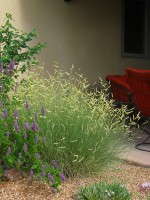The Changing Face Of Ornamental Grasses

The traditional grass palette for greenhouse growers usually includes a few tender selections for color and popular genera like pennisetum, miscanthus and festuca. Those plants are still valuable, and new, exciting varieties continue to emerge. But even more exciting is the changing demand for grasses.
What’s driving this change? It’s a shift from typical visual appeal to an appreciation for grasses’ exceptional qualities. Grasses are good-looking, but they also use minimal resources. They solve common landscape problems, such as soil erosion and intermittent water conditions. They are real workhorses in the landscape. Grasses help to create easy-care landscapes and containers with low water, fertilizer and pesticide use. Another selling point? Deer tend to avoid them.
The advantages of grasses and their allies suggest possibilities for growers. Abe Van Wingerden, owner of Metrolina Greenhouses, Inc., in Huntersville, N.C., sees the potential.
“Grasses continue to be a growth market for us, but not just the typical pennisetums in quart containers we have seen for years,” Van Wingerden says. “We are now seeing growth in different colors of grasses used to accent combination planters and larger 1- to 3-gallon sizes of monoculture containers. Grasses can be used for a variety of decorating and landscaping purposes, and I think we are just scratching the surface of the opportunities.”
Changes In The Landscape
At Hoffman Nursery, we’ve noticed an increase in large-scale plantings using grasses and sedges as groundcovers or alternatives to traditional turf grass. Demand for Carex pensylvanica (Pennsylvania sedge), with its fine-textured foliage and spreading habit, has exploded. Native grasses like Panicum virgatum (switchgrass) are increasingly used in large masses where turf once roamed. Other grasses and sedges enjoying greater popularity are Sporobolus heterolepis (prairie dropseed), Carex flacca (blue sedge), Carex appalachica (Appalachian sedge), and Bouteloua gracilis (blue grama grass).
Landscape contractors tell us there is a shift away from the heavy maintenance burden of turf and color plantings. Many grasses, particularly warm-season prairie natives, are well-adapted to difficult conditions. Fibrous roots systems make them drought tolerant, and once established, most need no supplemental irrigation. Their low disease incidence and adaptation to infertile soils means less need for pesticides and fertilizer. Maintenance and fuel costs decline when mowing is reduced. All this adds up to lower costs and less hassle, and that’s where grasses excel.
In addition to large projects, grasses are appearing more often on small-scale commercial and public sites. And that’s good news. It means consumers see sweeps of grasses at a local office building or tall grasses anchoring a color planting at a shopping mall. They see grasses used in new ways, and it’s catching their attention.
Grasses are also taking on roles usually reserved for shrubs and small trees such as screening and as anchors for large plantings. The upright, eight-foot Panicum virgatum ‘Cloud Nine’ creates a strong, graceful presence in the landscape. A faster growth rate and lower expense make grasses attractive alternatives to woodies when the budget is tight.
Looking Beyond The Usual
Two new North American native cultivars show why grasses merit a place in any grower’s program. They offer updated looks and great functionality. Bouteloua gracilis ‘Blonde Ambition’ is a low-growing, fine-textured grass for full sun. It produces a heavy set of delicate blonde seed heads in the summer. ‘Blonde Ambition’ was named a 2011 Plant Select Winner for its resistance to pests, exceptional performance in low water conditions, retail appeal and long-lasting attractiveness in gardens and containers. It’s also a smart alternative to traditional turf grass in areas with light foot traffic. ‘Blonde Ambition’ has been scarce in the trade as suppliers build numbers, but we expect to see more in 2014.
Another star comes out of a traditional landscape species, Schizachyrium scoparium (little bluestem). The new ‘Prairie Munchkin’ is compact and upright, with fantastic foliage color. The flower scapes display a mix of silver, pink, blue and maroon in summer, and turn deep orange-red in fall. Little bluestem has been used in naturalistic landscapes, such as meadows and prairie plantings. Yet, the neat habit and showy color of ‘Prairie Munchkin’ work well in formal settings and containers. It’s tough, beautiful and requires no babying. It also puts on a lovely late-season show, giving growers another option for fall sales.
For more color options, growers should consider the wider range of grasses that offer easy care, too. Panicum virgatum (switchgrass) cultivars, with red or blue foliage, are adaptable, drought tolerant and very cold hardy. They’re unexpectedly elegant in large containers and are outstanding landscape plants. But they don’t impress in a quart. Offer them in larger sizes so consumers see the beauty of a mature plant. Panicum virgatum and its cultivars are strong, warm season growers, so potting them up in spring for fall sales works perfectly.
Emerging Sedges
Along with grasses, sedges (Carex spp.) have taken off. They’re appearing on project lists in increasing numbers. North American natives form a diverse group and are adapted to a wide range of conditions. The selections vary in ornamental appeal. Some work best as background plants or in naturalistic settings, while others shine in the spotlight. Regardless, they’re all landscape problem-solvers. Carex pensylvanica, as noted earlier, is a hot ticket for use as a groundcover in shady sites. The demand for it is sparking interest in similar species, such as C. rosea, C. cherokeensis and C. eburnea.
Many Asian sedges make excellent groundcovers and offer a more formal look. They thrive in containers, and most are evergreen. Newer selections for color and splash include the exciting EverColor series developed in Ireland by Pat FitzGerald. These Carex oshimensis selections are knockouts. ‘Everest’ sports narrow, green foliage edged with white and an elegant, arching habit. In production, it’s shown greater vigor than its parent, ‘Evergold.’
‘Everillo’ turns up the visual volume with bright, gold foliage. It promises to be a best seller in the sedge world. Tony Avent of Plant Delights Nursery is a big fan, calling it, “one of the most exciting shade plants of the last decade.”
Mostly evergreen, the Evercolor series is a smart choice for winter containers in warmer and temperate regions. And they’re a great package for consumers requesting color and easy care.
For showiness and easy production, Cyperus albostriatus ‘Variegatus’ (dwarf striped umbrella sedge) should get a second look. It has unusual, umbrella-like blooms that stand out among foliage plants. The inflorescences emerge from the center of whorled, variegated foliage in a tiny starburst. The look is bright and exotic. Add the size advantage, about 18 inches, and you have a compact, beautiful plant. It’s tender or marginally hardy in most regions of North America, but is well-suited for containers and accent plantings in the landscape.
Open Up To Grasses
Grasses and sedges combine good looks and functionality with low maintenance needs — just what consumers are looking for now. That makes them increasingly valuable for growers. Now’s the time to expand your grass palette.










